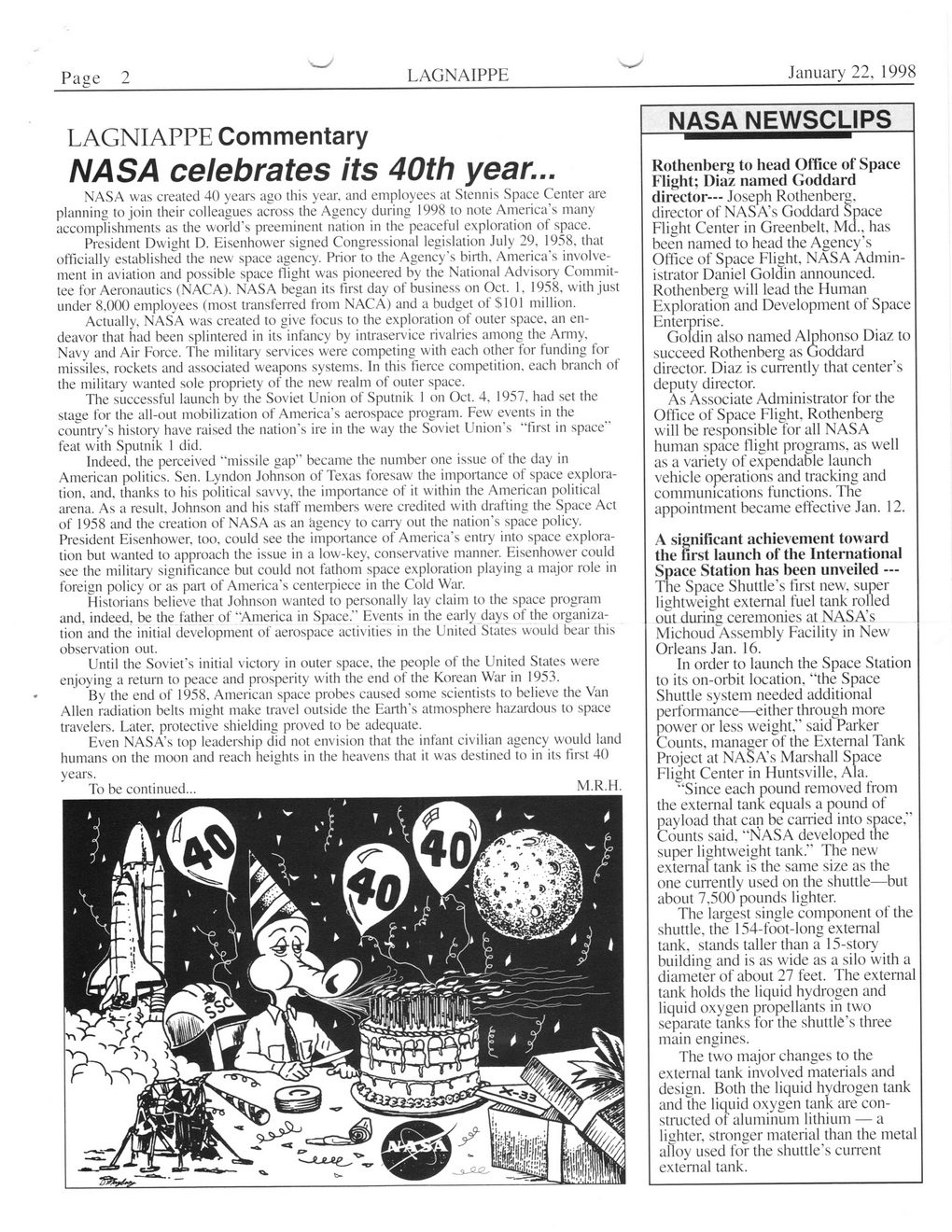This text was obtained via automated optical character recognition.
It has not been edited and may therefore contain several errors.
Page 2 LAGNAIPPE January 22, 1998 LAGNIAPPE Commentary NASA celebrates its 40th year... NASA was created 40 years ago this year, and employees at Stennis Space Center are planning to join their colleagues across the Agency during 1998 to note America’s many accomplishments as the world's preeminent nation in the peaceful exploration of space. President Dwight D. Eisenhower signed Congressional legislation July 29, 1958. that officially established the new space agency. Prior to the Agency's birth, America's involvement in aviation and possible space flight was pioneered by the National Advisory Committee for Aeronautics (NACA). NASA began its first day of business on Oct. 1. 1958, with just under 8.000 employees (most transferred from NACA) and a budget of $101 million. Actually, NASA was created to give focus to the exploration of outer space, an endeavor that had been splintered in its infancy by intraservice rivalries among the Army, Navy and Air Force. The military services were competing with each other for funding for missiles, rockets and associated weapons systems. In this fierce competition, each branch of the military wanted sole propriety of the new realm of outer space. The successful launch by the Soviet Union of Sputnik 1 on Oct. 4, 1957. had set the stage for the all-out mobilization of America’s aerospace program. Few events in the country's history have raised the nation's ire in the way the Soviet Union’s "first in space” feat with Sputnik 1 did. Indeed, the perceived “missile gap" became the number one issue of the day in American politics. Sen. Lyndon Johnson of Texas foresaw the importance of space exploration, and. thanks to his political savvy, the importance of it within the American political arena. As a result. Johnson and his staff members were credited with drafting the Space Act of 1958 and the creation of NASA as an agency to carry out the nation's space policy. President Eisenhower, too, could see the importance of America’s entry into space exploration but wanted to approach the issue in a low-key, conservative manner. Eisenhower could see the military significance but could not fathom space exploration playing a major role in foreign policy or as part of America’s centerpiece in the Cold War. Historians believe that Johnson wanted to personally lay claim to the space program and. indeed, be the father of "America in Space.” Events in the early days of the organization and the initial development of aerospace activities in the United States would bear this observation out. Until the Soviet's initial victory in outer space, the people of the United States were enjoying a return to peace and prosperity with the end of the Korean War in 1953. By the end of 1958, American space probes caused some scientists to believe the Van Allen radiation belts might make travel outside the Earth’s atmosphere hazardous to space travelers. Later, protective shielding proved to be adequate. Even NASA’s top leadership did not envision that the infant civilian agency would land humans on the moon and reach heights in the heavens that it was destined to in its first 40 years. To be continued... M.R.H. NASA NEWSCLIPS Rothenberg to head Office of Space Flight; Diaz named Goddard director— Joseph Rothenberg, director of NASA’s Goddard Space Flight Center in Greenbelt. Md., has been named to head the Agency’s Office of Space Flight, NASA Administrator Daniel Goldin announced. Rothenberg will lead the Human Exploration and Development of Space Enterprise. Goldin also named Alphonso Diaz to succeed Rothenberg as Goddard director. Diaz is currently that center’s deputy director. As Associate Administrator for the Office of Space Flight, Rothenberg will be responsible for all NASA human space flight programs, as well as a variety of expendable launch vehicle operations and tracking and communications functions. The appointment became effective Jan. 12. A significant achievement toward the first launch of the International Space Station has been unveiled — The Space Shuttle’s first new, super lightweight external fuel tank rolled out during ceremonies at NASA’s Michoud Assembly Facility in New Orleans Jan. 16. In order to launch the Space Station to its on-orbit location, “the Space Shuttle system needed additional performance—either through more power or less weight,” said Parker Counts, manager of the External Tank Project at NASA’s Marshall Space Flight Center in Huntsville, Ala. “Since each pound removed from the external tank equals a pound of payload that can be carried into space,” Counts said, “NASA developed the super lightweight tank.” The new external tank is the same size as the one currently used on the shuttle—but about 7,500 pounds lighter. The largest single component of the shuttle, the 154-foot-long external tank, stands taller than a 15-story building and is as wide as a silo with a diameter of about 27 feet. The external tank holds the liquid hydrogen and liquid oxygen propellants in two separate tanks for the shuttle’s three main engines. The two major changes to the external tank involved materials and design. Both the liquid hydrogen tank and the liquid oxygen tank are constructed or aluminum lithium — a lighter, stronger material than the metal alloy used for the shuttle’s current external tank.

NASA Document (016)